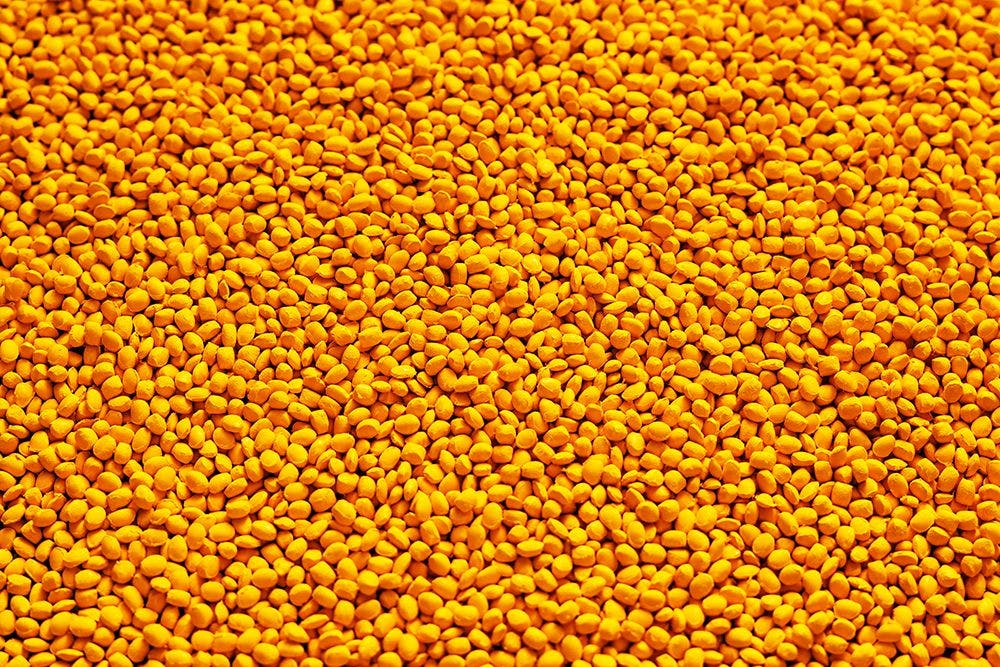Extraction and Analysis of Contaminants in Water with Particulate Matter Using SBSE
A highly sensitive method for quantitative determination of contaminants in surface waters, with and without particulate matter, was tested using stir-bar sorptive extraction (SBSE).
amixstudio/stock.adobe.com
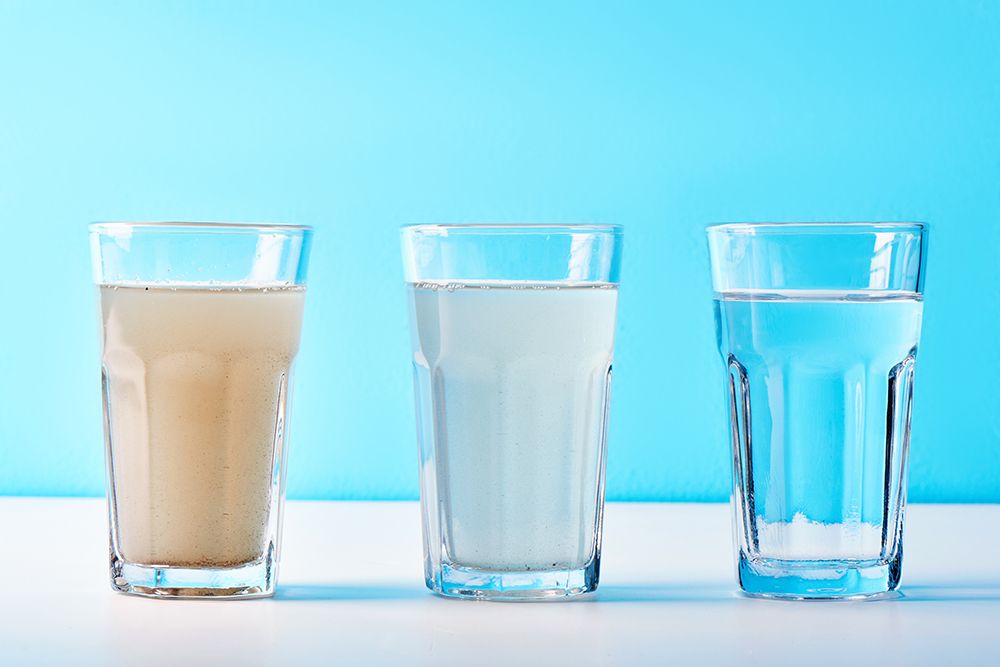
A highly sensitive method for quantitative determination of around 100 contaminants in surface waters with and without particulate matter is presented in this work. The method is based on the EU Water Framework Directive (EU-WFD) (2013/39/EU) requirements. The key element of the gas chromatography–tandem mass spectrometry (GC–MS/MS)-based method is stir-bar sorptive extraction (SBSE), an efficient analyte concentration technique for water analysis. Dichloromethane is eliminated from the process and the amounts of sample and solvent used are reduced significantly, to the benefit of both the environment and laboratory occupational hygiene.
In 2000, the European Union (EU) Parliament and the Council released Directive (2000/60/EC) that focuses on the protection and improvement of the quality of surface waters and ground water (1). The directive in its own words, “lays down a strategy against the pollution of water. That strategy involves the identification of priority substances that pose a significant risk to, or via, the aquatic environment at (European, Ed.) Union level”. This EU Water Framework Directive (WFD) was extended and amended in 2008 (2008/105/EC) (2) and in 2013 (2013/39/EU) (3). The EU WFD mandates that all member states must take measures to continually monitor and improve the condition and quality of water bodies in their territory. Parameters to be monitored include a range of specified key chemical pollutants, the priority substances are listed.
EU environmental quality standards (EQSs) (5) specify maximum allowable concentration (MAC) levels for pollutants in surface waters that must be adhered to within the foreseeable future. The directive states: “With the aim of achieving good surface water chemical status in relation to those substances by 22 December 2021 by means of programmes of measures included in the 2015 river basin management plans…”. In the EQS that applies to surface waters, the authors differentiate between annual average concentration (AA‑EQS) and maximum allowable concentration (MAC‑EQS) levels specified for “inland surface waters”, such as rivers and lakes, or for “other surface waters”, listed as transitional, coastal and territorial waters.

A Closer Look at The Requirements
Commission Directive 2009/90/EC (6) provides technical details for the chemical analysis and monitoring specified in the EU‑WFD. Minimum performance criteria for analytical methods are specified, such as limits of quantification (LOQs). Compound LOQs lower than 30% of the respective annual average EQS (AA‑EQS) values are required, for some compounds in the low- to sub‑nanogram range per litre. For example, the required LOQ for benzo[a]pyrene is 0.051 ng/L. Reaching such levels requires a highly efficient analyte concentration technique, such as stir-bar sorptive extraction (SBSE), combined with a highly sensitive analysis technique. In addition, the uncertainty of measurement must be lower than 50% (k=2) at the specified EQS concentration value. If these criteria cannot be met, due to a lack of suitable analysis methods, the EU-WFD offers some freedom: Monitoring should then be performed using the best available method that doesn’t lead to excessive cost.
Environmental Impact of Laboratory Analysis
Traditional water analysis methods rely on liquid–liquid extraction (LLE) of a 1 L sample volume, typically in two separate steps under different conditions using a total of 100 mL ultra‑pure dichloromethane per sample. In order to reach the required LOQs, the combined extracts are then concentrated by a factor of 100, by evaporation to 1 mL. The required replicates and blanks obviously add to the amount of dichloromethane used per analysis, and thus to the environmental impact. The large sample volumes required pose logistical challenges and add cost, such as for cleaning, storing, and transporting glassware and samples. The EU‑WFD affords a performance‑based freedom of choice. Using modern solvent‑free or solvent‑reduced extraction techniques and combining these with the increasingly sensitive analysis instruments enables a more environmentally sustainable analysis and, last, but not least, improved occupational safety for laboratory staff.
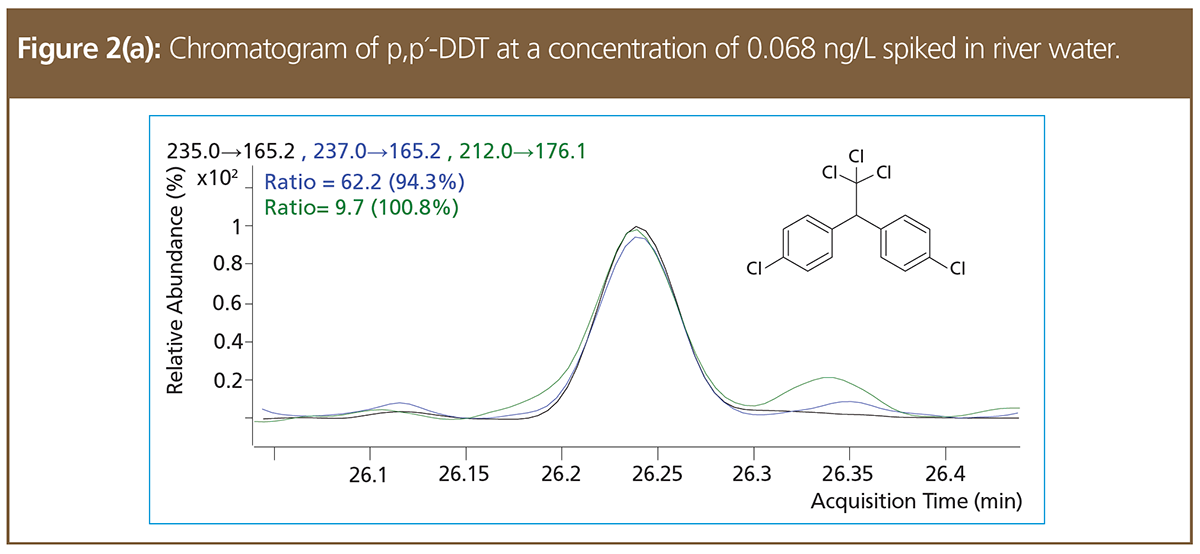
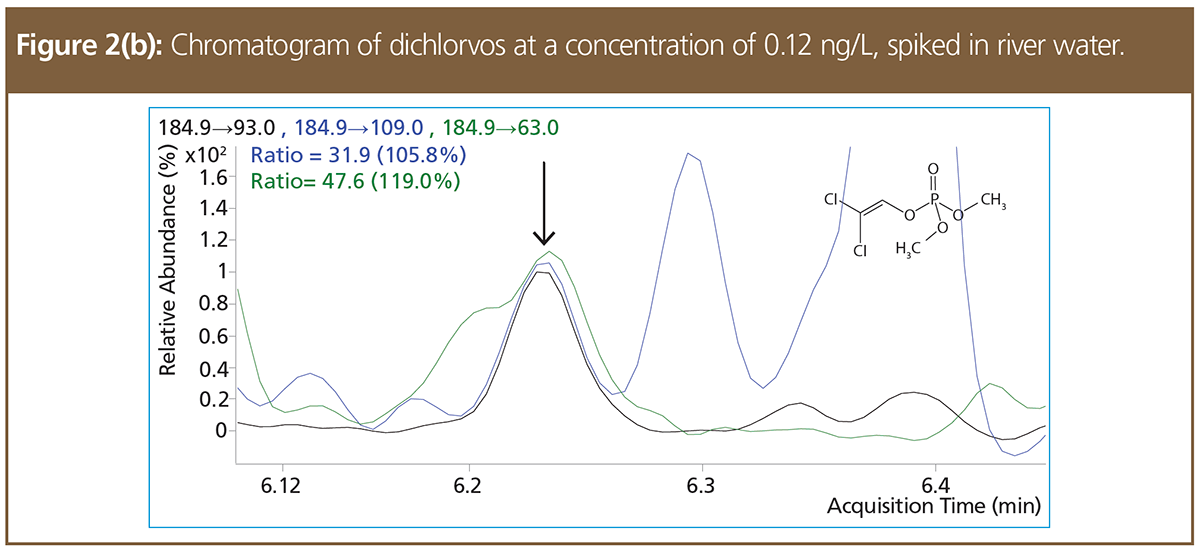
Proven Water Analysis Technique
SBSE has long been used for environmental water analysis and has performed well in round-robin tests. In 2009, the Bavarian Environment Agency (LfU), Germany, demonstrated SBSE performance in full compliance with the requirements of the German Federal Ministry of Health’s Drinking Water Ordinance (TrinkwV 2001) (7). Furthermore, SBSE was previously successfully used for the determination of priority pollutants in surface waters following the EU WFD 2000/60/EU (1). As a result of a significant investment of time and resources, the SBSE method has recently been optimized for highly sensitive determination of the GC compatible priority pollutants listed in EU Directive 2013/39/EU (3)—including pollutants adsorbed to particulate matter—using one comprehensive method.
A Detailed Look at SBSE
The extraction medium used in SBSE is a glass‑coated magnetic stir‑bar mounted with a substantial sorbent layer. The sorbents used are either polydimethylsiloxane (PDMS) or a combination of ethylene glycol (EG) and PDMS that covers a wider polarity range. The extraction principle of SBSE, like that of liquid–liquid extraction (LLE), relies on partitioning, reaching equilibrium between the aqueous sample and the sorbent phase. In the work described here, PDMS‑coated stir‑bars were used. Analyte extraction and concentration takes place while the sample is stirred. Subsequently, the stir‑bar is removed from the sample, quickly dried, placed in a glass liner for thermal desorption, and the liner placed in a sealed sample tray position on the autosampler, awaiting automated sequential batch processing in combination with a thermal desorber. Following thermal desorption, analytes are focused in a gas chromatography (GC) inlet and subsequently transferred to the GC column in split or splitless mode using programmable heating. This approach ensures that extracted analytes can be transferred up to 100% to the column for extreme sensitivity. The PDMS‑coated stir‑bar is well suited for non‑polar to medium polarity compounds while the stir‑barcoated with PDMS and ethylene is mainly used for polar compounds that form hydrogen bonds as proton donor, for example phenols, alcohols and organic acids.
Simple and Efficient Water Analysis
In this work, SBSE was our method of choice for the GC-compatible compounds listed in the EU‑WFD. In addition to reaching the prescribed LOQs, we also wanted to perform quantitative determination of compounds adsorbed on particulate matter, as demanded by the EU‑WFD, including polyaromatic hydrocarbons (PAHs). The overall analysis requires a special approach: At first, we added an internal standard to individual 100 mL samples, which is a large enough volume to generate meaningful results. We performed classical SBSE with PDMS sorbent for five hours to extract free organic compounds. The stir‑bar was then removed, an organic modifier added to the sample along with a second PDMS stir‑bar, and the sample extracted at elevated temperature overnight. Using this approach, compounds adsorbed on particulate matter were successfully released and extracted and the two stir‑bars thermally desorbed together for combined GC–MS/MS determination of the extracted analytes. Up to 15 samples are extracted in parallel on each heated stir plate; the number of stir plates thus determines the sample extraction throughput.
Experimental
For sample extraction 1 cm /1 mm (length / phase thickness) conditioned PDMS coated stir‑bars (Gerstel Twister) were used. Samples were filled into individual 100-mL vials and a stir‑bar and 30 µL of internal standard added to each vial before sealing it with a crimp cap. A heated stirring plate (Gerstel) was utilized for the extraction at 1000 rpm for 5 h. The stir‑bar was removed, rinsed in high performance liquid chromatography (HPLC)‑grade water, dried in a flow of nitrogen and placed in a sealed thermal desorption tube for storage. An organic modifier and a second stir‑bar were added to the sample before extracting it a second time at 1000 rpm and elevated temperature over a 17 h period. The second stir‑bar was then added to the first in the same sealed desorption tube on the autosampler tray (MultiPurpose Sampler MPS robotic, Gerstel). The MPS sequentially transferred the tubes with the stir‑bars to the thermal desorber (TDU 2, Gerstel). Analytes were thermally desorbed and transferred to the GC–MS/MS system (7890 GC / 7010 triple quadrupole MS, both Agilent Technologies) for determination in multiple reaction monitoring (MRM) mode. The water used for calibration should be as similar as possible to the water of the real samples, very clean groundwater, tap water, or mineral water were found to be suitable for calibration whereas groundwater gave the best results regarding trueness of analysis values. Samples to be analyzed should have a pH between 5.5 and 7; if necessary, the pH value can be adjusted. Additional details are available in a separate publication (4).
Successful Determination of Water Contaminants
The newly developed SBSE–GC–MS/MS method presented here is both efficient and highly sensitive. We were able to determine the GC-compatible compounds listed in the EU‑WFD at the levels specified—or even well below—with three exceptions: cypermethrin, heptachlor, and heptachlor epoxide. Those three are also notoriously hard to determine at the required levels down to sub-pg/L using conventional techniques.
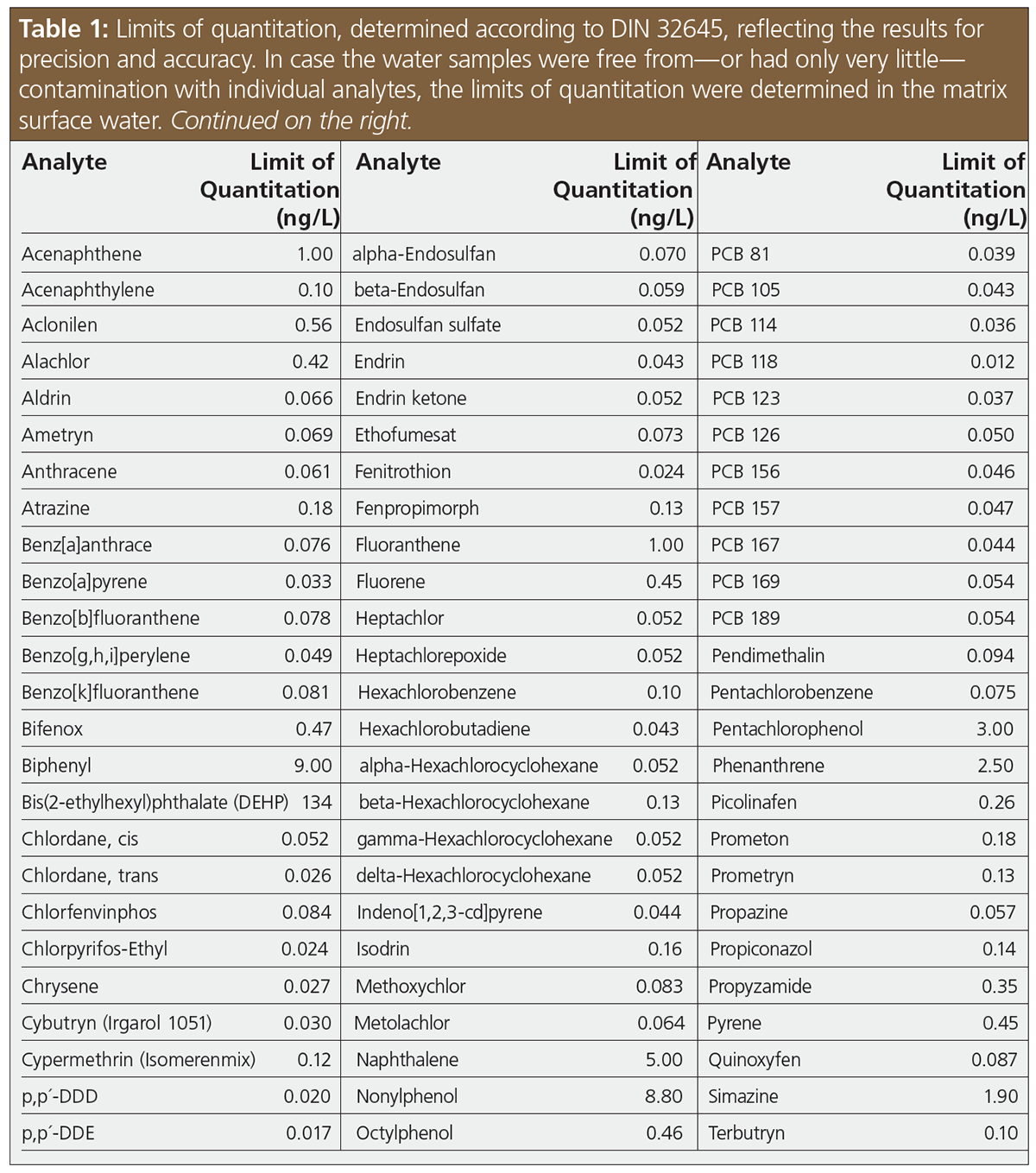
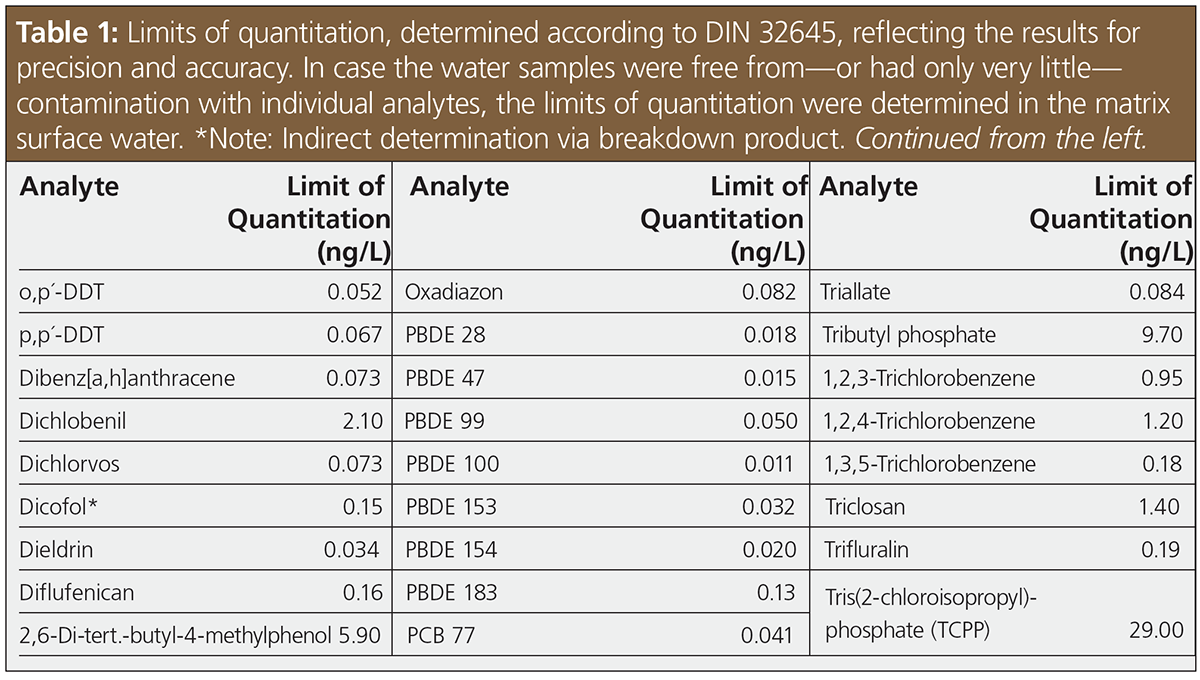
In the following, a few examples of required limits of quantitation for surface water following the EU guidelines are listed. For dichlorvos: 0.18 ng/L; using SBSE, we reached 0.073 ng/L. For benzo(a)pyrene: 0.051 ng/L; using SBSE, we reached 0.033 ng/L. For pentachlorobenzene: LOQ of 2.1 ng/L; with SBSE, we lowered it to 0.075 ng/L (see Table 1). Comparable results were achieved for around 100 other contaminants relevant for surface water analysis. Relative standard deviations (RSDs) near the respective limits of quantitation were between 2–10% for the vast majority of compounds with a median of 6.9%. Trueness was between 90–110% in most cases. Real-world water samples, such as river-, ground-, tap-, mineral water, and effluents from sewage treatment plants, were analyzed without any issues. For none of the analytes, a major co‑elution was found on the quantifier ion transition and each analyte had at least one qualifier ion transition without co‑elution. The extractability and quantifiability of analytes adsorbed on particulate matter was tested and confirmed using a certified reference sediment (WEPAL SETOC 745) (8), results for selected compounds are shown in Figure 3. Some certified analysis results were available for PAHs and a few chlorinated compounds.
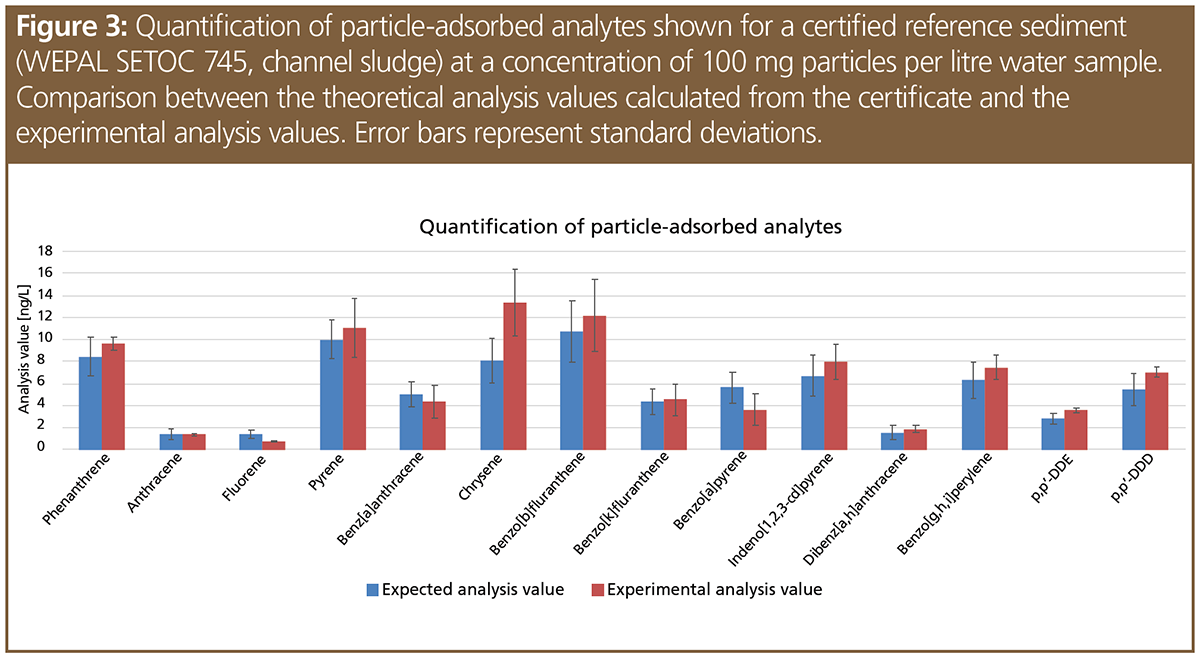
Assessing SBSE
SBSE is simple to perform and highly efficient, resulting in high sensitivity, not only in the case described here, in which we successfully determined priority pollutants listed in the EU‑WFD. The high sensitivity is mainly due to the large volume of the SBSE sorbent phase, in this case 63 µL, which guarantees a high extraction efficiency and recovery, obviously important when doing trace analysis. When the SBSE sorbent phase is thermally desorbed, the analytes extracted from the sample are transferred quantitatively to the GC, whereas when performing liquid extraction and injection, only a small aliquot is injected. SBSE performed on a 100 mL water sample coupled with thermal desorption and a highly sensitive triple quadrupole mass spectrometer (TQMS) provides extremely low LOQs, reaching the sub‑ng/L range. A further bonus of using the SBSE technique is that the entire method requires only a very small amount of solvent. Many solvents are toxic, hazardous, and harmful to the environment. Therefore, a reduction in the amount used would seem particularly meaningful and fitting in order to reach environmentally sustainable environmental analysis and to provide best possible occupational hygiene for laboratory staff.
References
- European Union, Directive 2000/60/EC of the European Parliament and of the Council of 23 October 2000 establishing a framework for Community action in the field of water policy, Document 32000L0060, OJ L327, 0001–0073 (Brussels, Belgium, 2000). https://eur-lex.europa.eu/eli/dir/2000/60/oj (Accessed October 2020).
- European Union, Directive 2008/105/EC of the European Parliament and of the Council of 16 December 2008 on environmental quality standards in the field of water policy, amending and subsequently repealing Council Directives 82/176/EEC, 83/513/EEC, 84/156/EEC, 84/491/EEC, 86/280/EEC and amending Directive 2000/60/EC of the European Parliament and of the Council, Document 32008L0105, OJ L348, 84–97 (Brussels, Belgium, 2008). https://eur-lex.europa.eu/eli/dir/2008/105/oj (Accessed October 2020).
- European Union, Directive 2013/39/EU of the European Parliament and of the Council of 12 August 2013 amending Directives 2000/60/EC and 2008/105/EC as regards priority substances in the field of water policy Text with EEA relevance, Document 32013L0039, OJ L226, 1–17 (Brussels, Belgium, 2013). https://eur-lex.europa.eu/eli/dir/2013/39/oj (Accessed October 2020).
- O. Lerch, J. Zboron, K. Brady, and J.-L. Aybar, “Highly Sensitive Determination of Contaminants in Surface Water in the Context of the EU Water Framework Directive using Stir Bar Sorptive Extraction (SBSE) and GC-MS/MS”, Gerstel Application Note 196 (Mulheim an der Ruhr, Germany).
- European Union, Directive 2008/105/EC of the European Parliament and of the Council of 16 December 2008 on environmental quality standards in the field of water policy, amending and subsequently repealing Council Directives 82/176/EEC, 83/513/EEC, 84/156/EEC, 84/491/EEC, 86/280/EEC and amending Directive 2000/60/EC of the European Parliament and of the Council. Document 32008L0105, OJ L 348, 24.12.2008, 84–97.
- European Union, Commission Directive 2009/90/EC of 31 July 2009 laying down, pursuant to Directive 2000/60/EC of the European Parliament and of the Council, technical specifications for chemical analysis and monitoring of water status (Text with EEA relevance). Document 32009L0090, OJ L 201, 1.8.2009, 36–38.
- German Federal Ministry of Health Drinking Water Ordinance (TrinkwV). https://www.bundesgesundheitsministerium.de/english-version/topics/drinking-water-ordinance.html
- http://www.wepal.nl/website/download_files/consensus/SETOC/SETOC745.pdf (Accessed October 2020)
Oliver Lerch works as Senior Application Scientist in the Analytical Services Department at Gerstel. After receiving his Ph.D. from the Ruhr University Bochum, Germany, in 2003, he worked at the Max-Planck-Institute of Molecular Plant Physiology in Potsdam, Germany, before joining Gerstel in 2005 where he has been instrumental in the development of technologies and products. These include applied customer projects on automated GC/MS and LC/MS solutions.
Jasmin Zboron joined the Gerstel Analytical Services department in 2015 as Application Specialist, after completing her B.Sc. Following projects on determining priority contaminants in water, her main focus is currently on GC/MS sample preparation and application development.
E-mail: Oliver_Lerch@Gerstel.de
Website: www.gerstel.com
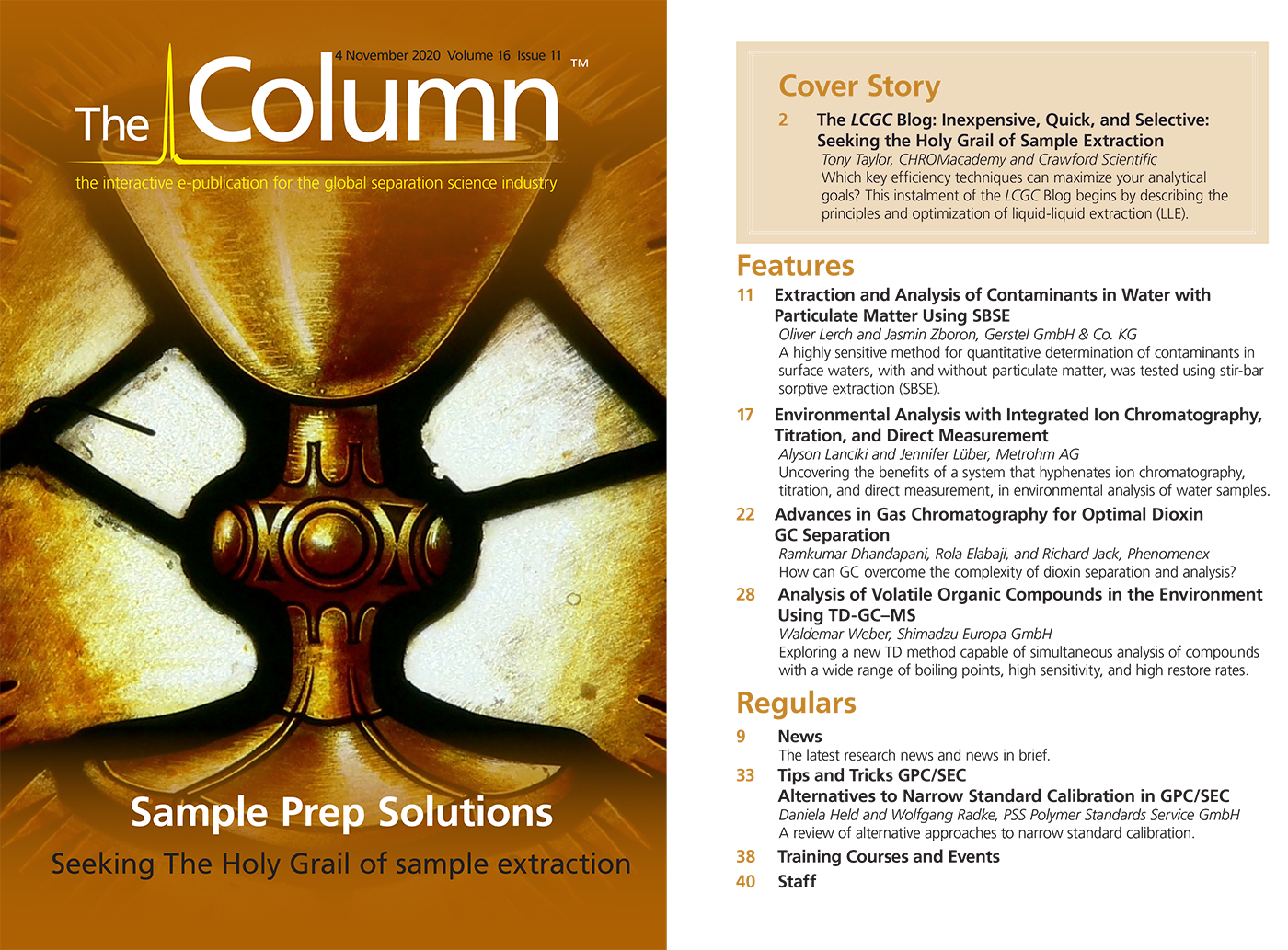
Characterizing Plant Polysaccharides Using Size-Exclusion Chromatography
April 4th 2025With green chemistry becoming more standardized, Leena Pitkänen of Aalto University analyzed how useful size-exclusion chromatography (SEC) and asymmetric flow field-flow fractionation (AF4) could be in characterizing plant polysaccharides.






